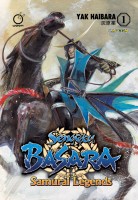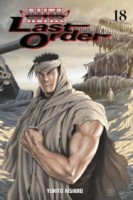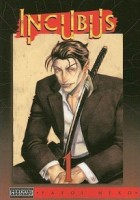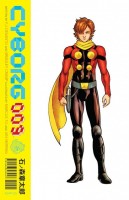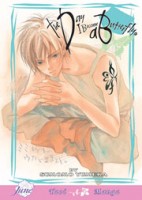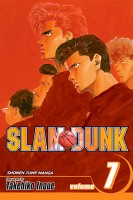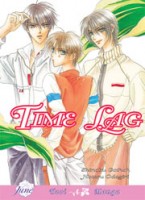My News and Reviews
It was another two-review week last week. My Blade of the Immortal review project continues with Hiroaki Samura’s Blade of the Immortal, Volume 26: Blizzard. The volume includes the conclusion to the battle between Manji and Shira and it does not disappoint. The second review posted last week was for Tomoyuki Hoshino’s novel Lonely Hearts Killer. It’s not easy reading, and I didn’t like it quite as well as Hoshino’s collection of short fiction We, the Children of Cats, but I found it to be an intriguing work.
Last week I also had the opportunity to attend a fascinating lecture on queer theory, Japanese literature, and translation. I decided to share some of my random musings on the topics. So far the post seems to have been well received, which makes me pretty happy.
There were a couple of particularly interesting posts by Erica Friedman over at Yuricon last week. Her New York Comic Con report includes more information about One Peace Books’ licensing of Takashi Ikeda’s yuri manga Whispered Words. (I’m looking forward to the release of Whispered Words a great deal.) Also interesting was her post A Very Important Thing About Licensing Manga Fans Don’t Really Understand which explains a few of the complexities involved in licensing manga for English-reading audiences.
Quick Takes
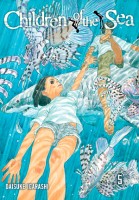 Children of the Sea, Volume 5 by Daisuke Igarashi. In Japan, the fifth and final volume of Children of the Sea was released three years after the fourth volume was published. The English-language edition of the series likewise followed suit. But the end is finally here! I was actually surprised that the fifth volume was the conclusion of the series. To me it felt as though Igarashi had much more in store for Children of the Sea. I don’t know the circumstances surrounding the series’ end, but I am a little sad that he wasn’t able to develop it further. However, almost everything is tied up satisfactorily plot-wise and the series’ sense of mystery and awe remains intact. Children of the Sea is like modern myth. There is relatively little dialogue and narration in the fifth volume; Igarashi’s artwork really carries the manga at this point. And that artwork is absolutely beautiful. The attention given to the realistic details of the water and sea-life is stunning.
Children of the Sea, Volume 5 by Daisuke Igarashi. In Japan, the fifth and final volume of Children of the Sea was released three years after the fourth volume was published. The English-language edition of the series likewise followed suit. But the end is finally here! I was actually surprised that the fifth volume was the conclusion of the series. To me it felt as though Igarashi had much more in store for Children of the Sea. I don’t know the circumstances surrounding the series’ end, but I am a little sad that he wasn’t able to develop it further. However, almost everything is tied up satisfactorily plot-wise and the series’ sense of mystery and awe remains intact. Children of the Sea is like modern myth. There is relatively little dialogue and narration in the fifth volume; Igarashi’s artwork really carries the manga at this point. And that artwork is absolutely beautiful. The attention given to the realistic details of the water and sea-life is stunning.
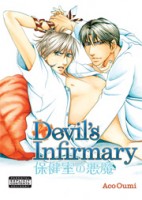 Devil’s Infirmary by Aco Oumi. Asakura is a physician at an all boys’ school who is not above accepting sexual advances from the students. Things get a little more complicated when Higurashi walks in on Asakura getting a blow job, but Asakura has a few compromising photographs with which to blackmail Higurashi into keeping quiet about it. Supposedly Asakura is in love with Higurashi, but I’m really not convinced. Their relationship is a very inappropriate one and Asakura, though he has a few redeeming qualities, is actually kind of creepy. (But Higurashi’s pretty cute.) At the same time, there are some legitimately funny and occasionally even hilarious moments in Devil’s Infirmary, too. One of Higurashi’s closest friends has a “sparkle problem” that unfortunately brings him unwanted attention from a few of the other students. It’s rather entertaining to see Higurashi try to pose as his boyfriend to deflect some of that interest. And then there’s Asakura’s mother who bribes her gay son into buying her yaoi manga.
Devil’s Infirmary by Aco Oumi. Asakura is a physician at an all boys’ school who is not above accepting sexual advances from the students. Things get a little more complicated when Higurashi walks in on Asakura getting a blow job, but Asakura has a few compromising photographs with which to blackmail Higurashi into keeping quiet about it. Supposedly Asakura is in love with Higurashi, but I’m really not convinced. Their relationship is a very inappropriate one and Asakura, though he has a few redeeming qualities, is actually kind of creepy. (But Higurashi’s pretty cute.) At the same time, there are some legitimately funny and occasionally even hilarious moments in Devil’s Infirmary, too. One of Higurashi’s closest friends has a “sparkle problem” that unfortunately brings him unwanted attention from a few of the other students. It’s rather entertaining to see Higurashi try to pose as his boyfriend to deflect some of that interest. And then there’s Asakura’s mother who bribes her gay son into buying her yaoi manga.
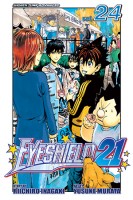 Eyeshield 21, Volumes 24-27 written by Riichiro Inagaki and illustrated by Yusuke Murata. By this point I am no longer surprised that I enjoy Eyeshield 21. I still don’t have a particular interest in American football (and I doubt I ever will even considering the number of years I spent in marching band), but the characters, comedy, and art in the series are great. These four volumes are devoted to the Kanto Tournament game between the Deimon Devil Bats and the Ojo White Knights, both teams fighting to advance one step closer to the Christmas Bowl. The Devil Bats are considered to have one of the best offenses in the tournament but the White Knights are considered to have the best defense. The White Knights also have Seijuro Shin—as perfect a player as there can be. The game ends up being very close, and therefore very exciting; Inagaki keeps the readers guessing right up to the very last second. Murata’s dynamic artwork continues to be one of the highlights of the series. His creative imagery is a little more restrained in these volumes, focusing more on the action of the game and slightly less on its psychological impact, but it’s definitely still there.
Eyeshield 21, Volumes 24-27 written by Riichiro Inagaki and illustrated by Yusuke Murata. By this point I am no longer surprised that I enjoy Eyeshield 21. I still don’t have a particular interest in American football (and I doubt I ever will even considering the number of years I spent in marching band), but the characters, comedy, and art in the series are great. These four volumes are devoted to the Kanto Tournament game between the Deimon Devil Bats and the Ojo White Knights, both teams fighting to advance one step closer to the Christmas Bowl. The Devil Bats are considered to have one of the best offenses in the tournament but the White Knights are considered to have the best defense. The White Knights also have Seijuro Shin—as perfect a player as there can be. The game ends up being very close, and therefore very exciting; Inagaki keeps the readers guessing right up to the very last second. Murata’s dynamic artwork continues to be one of the highlights of the series. His creative imagery is a little more restrained in these volumes, focusing more on the action of the game and slightly less on its psychological impact, but it’s definitely still there.
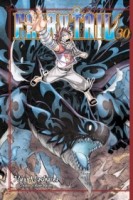 Fairy Tail, Volume 30 by Hiro Mashima. With these volumes, Fairy Tail launches into a new story arc. The technique that Mashima uses—a time skip—isn’t all that unusual for a lengthy shounen manga series. What makes it different, and something that I personally haven’t encountered before, is that only part of the cast jumps ahead while most of the main characters are stuck in time. It makes it a little more interesting when returning after seven years that they have to come to terms with the fact that so many of their friends (and enemies) have changed and grown more powerful. The time skip also serves the purpose of “resetting” the story—Fairy Tail is once again one of the weakest guilds and has to fight its way back to the top. But instead of facing off with evil wizards and guilds, this time they’ll be competing in the Grand Magic Games. Honestly, I’m not quite as interested in this particular turn of events, but at least there should be some entertaining trials and competitions as a result.
Fairy Tail, Volume 30 by Hiro Mashima. With these volumes, Fairy Tail launches into a new story arc. The technique that Mashima uses—a time skip—isn’t all that unusual for a lengthy shounen manga series. What makes it different, and something that I personally haven’t encountered before, is that only part of the cast jumps ahead while most of the main characters are stuck in time. It makes it a little more interesting when returning after seven years that they have to come to terms with the fact that so many of their friends (and enemies) have changed and grown more powerful. The time skip also serves the purpose of “resetting” the story—Fairy Tail is once again one of the weakest guilds and has to fight its way back to the top. But instead of facing off with evil wizards and guilds, this time they’ll be competing in the Grand Magic Games. Honestly, I’m not quite as interested in this particular turn of events, but at least there should be some entertaining trials and competitions as a result.
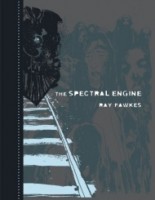 The Spectral Engine by Ray Fawkes. I am not especially familiar with Ray Fawkes—an award-winning and frequently award-nominated Canadian creator—and so I was unaware of the upcoming release of The Spectral Engine. Happily, a review copy unexpectedly showed up in the mail. Otherwise, I would probably have completely missed it and that would have been a shame. The Spectral Engine is a great graphic novel and I’m glad I had the opportunity to read it. The artwork in particular is excellent, using dark, dripping lines and ink spatter reminiscent of the smoke and grime of the titular engine to effectively create an unnerving atmosphere appropriate for the ghost stories being told. The Spectral Engine weaves together thirteen tragic historic events from many different time periods and locations across Canada. These retellings are paired with their related modern-day hauntings and reports of unexplained phenomena. In many cases the names and lives of the dead have been forgotten, but their stories and legends live on.
The Spectral Engine by Ray Fawkes. I am not especially familiar with Ray Fawkes—an award-winning and frequently award-nominated Canadian creator—and so I was unaware of the upcoming release of The Spectral Engine. Happily, a review copy unexpectedly showed up in the mail. Otherwise, I would probably have completely missed it and that would have been a shame. The Spectral Engine is a great graphic novel and I’m glad I had the opportunity to read it. The artwork in particular is excellent, using dark, dripping lines and ink spatter reminiscent of the smoke and grime of the titular engine to effectively create an unnerving atmosphere appropriate for the ghost stories being told. The Spectral Engine weaves together thirteen tragic historic events from many different time periods and locations across Canada. These retellings are paired with their related modern-day hauntings and reports of unexplained phenomena. In many cases the names and lives of the dead have been forgotten, but their stories and legends live on.
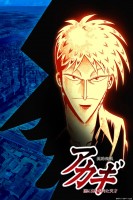 Akagi, Episodes 14-26 directed by Yuzo Sato. While the first half of Akagi had several different mahjong matches, the second half focuses on one: Akagi Shigeru versus Washizu Iwao. It also features a very special and slightly terrifying version of mahjong in which three-quarters of the tiles are transparent (which are beautifully animated). This reveals more of the players’ hands and greatly changing the dynamics of the game. (Though initially a fictional game, Washizu Mahjong sets now really do exist.) The game with Washizu also provides Akagi with something that he’s been looking for—a literal death match. Instead of money, he’s gambling with his blood and therefore his life. Akagi is a fearless and fearsome player and the game is ridiculously intense as a result. There’s skill, and there’s luck, but even more important are the psychological attacks used to provoke and manipulate the other players. Even when most of the tiles can been seen there’s still plenty of room for bluffing . I love mahjong and unsurprisingly I loved Akagi, too.
Akagi, Episodes 14-26 directed by Yuzo Sato. While the first half of Akagi had several different mahjong matches, the second half focuses on one: Akagi Shigeru versus Washizu Iwao. It also features a very special and slightly terrifying version of mahjong in which three-quarters of the tiles are transparent (which are beautifully animated). This reveals more of the players’ hands and greatly changing the dynamics of the game. (Though initially a fictional game, Washizu Mahjong sets now really do exist.) The game with Washizu also provides Akagi with something that he’s been looking for—a literal death match. Instead of money, he’s gambling with his blood and therefore his life. Akagi is a fearless and fearsome player and the game is ridiculously intense as a result. There’s skill, and there’s luck, but even more important are the psychological attacks used to provoke and manipulate the other players. Even when most of the tiles can been seen there’s still plenty of room for bluffing . I love mahjong and unsurprisingly I loved Akagi, too.



